HOVERFLIES
Hoverflies are a fascinating group of insects. They belong to the family Syrphidae, a family within the order Diptera (true flies). As they are often brightly coloured and very common in gardens many people will be familiar with them. Many have black and yellow markings and so are often confused with bees and wasps. However hoverflies are totally harmless and are definitely a gardener's friend, as the larvae of several common species have a voracious appetite for aphids! [Nature Spot website].
Not to be confused with wasps . They are directly related to drone flies.
See WASPS and DRONE FLIES
COMMON BANDED HOVERFLY : Syrphus ribesii
The Wildlife Trusts asserts that its name is very appropriate. it is not only one of our most common species, its black body is also covered in yellow bands! It can be seen in many habitats from gardens to woodlands.
Adults feed on the nectar of flowers, while the larvae are predators of aphids. This hoverfly has multiple broods; adults are seen throughout spring and summer, while the larvae survive the winter as pupae. The common banded hoverfly creates a hum when resting by vibrating its wings.
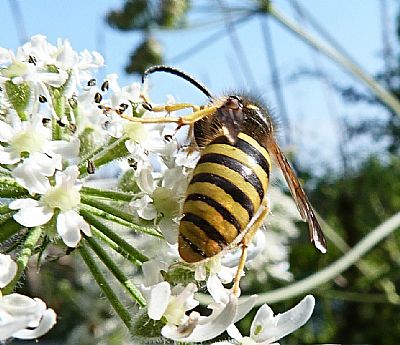
This little creature settles on a flower next to you. You panic as it appears to be a bee ... or a wasp. But look closer. It is neither. It is a harmless common hoverfly.
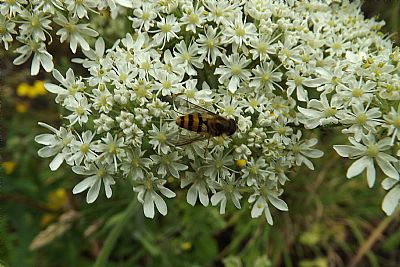
A hoverfly enjoys some cow parley nectar in mid-summer.
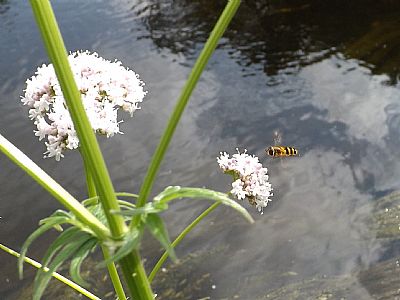
Here is one hovering at a pink cowparsley plant on the upper Leven.
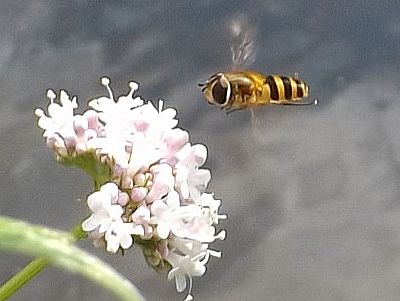
An efficient little hovering creature that appears almost like an alien space ship with large viewing windows.
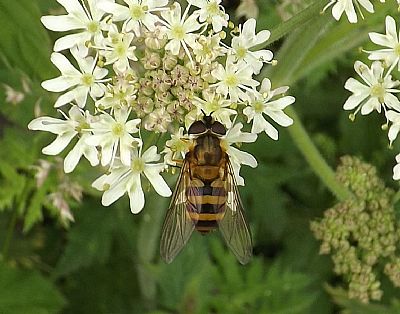
They can look much like honey bees and wasps, but look out for the typcal orange and black bands, the one nearest the thorax havng a central connecting line.
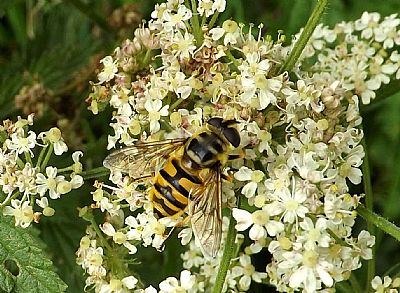
A hoverfly has no "waspish waist" and this common hoverfly is quite wide.
ERISTALIS NEMORUM
This smart hoverfly is mainly black with complete thin white lines and the typical yellow-brown shoulder cape not quite touching in the centre. NatureSpot tells us it is : A small drone-fly and quite similar to E. arbustorum (the dwarf drone-fly). The small but crisp dark patch on the front edge of the wings (called a stigma) helps to identify this species. It also has a clean and relatively thin black stripe down its face.
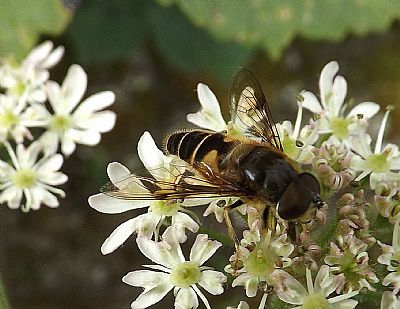
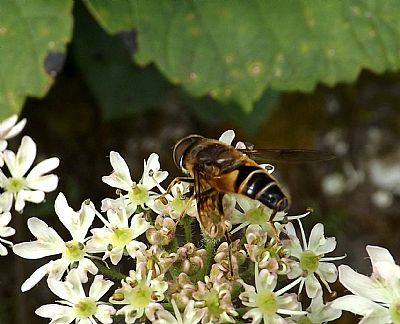
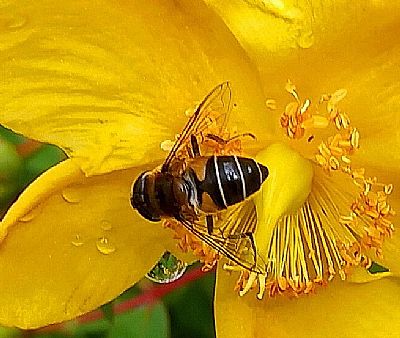
MARMALADE HOVERFLY : Episyrphus balteatus
This is so similar to the common banded hoverly above. A differentiating feature are the thinner secondary black banding between the broader ones. Also see the inconfirmed hoverfly at the end of this page, the lack of stripes on its underside which may simply be an indication of gender.
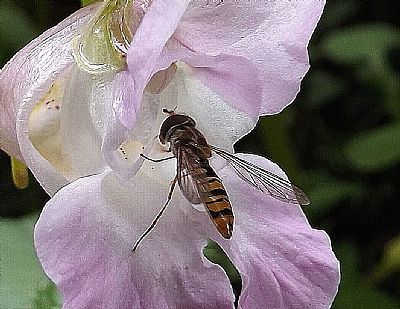
A marmalade hoverfly pollinating a himalyan balsam flower. (See invasive plants - HIMALAYAN BALSAM index.asp?pageid=732739 ). Heather Avenue, Alexandria. July.
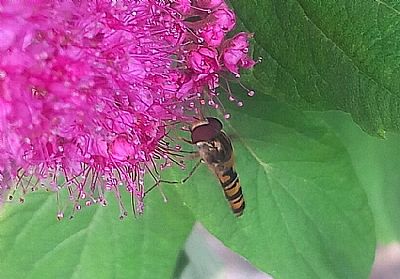
This marmalade hoverfly is enjoying a brideswort flower index.asp?pageid=733227 in late July. The narrow intermediate bands on these hoverflies look lamost white, but can be orange like the broader bands.
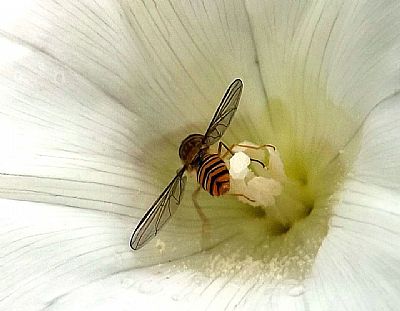
A marmalade hoverfly enjoys a bindweed flower in September.
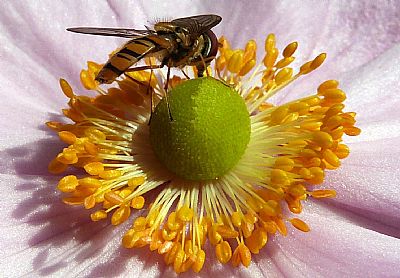
Seen in July.
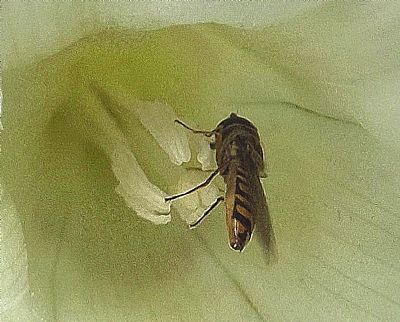
See on a bindweed flower in August. This looks like a marmalade hoverfly except that the banding is only on top and not wrapped around even partially. Banding forms almost complete recatngles x 3 filled with a darker arange. Does this slight difference in banding indicate gender rather than species?
MELANOSTORNA MELLINUM
This is a very common species of hoverfly found in many parts of Britain, Europe including the Mediterranean basin and North Africa, the East Palearctic, and North America. The larvae are suspected to be a general predator of small insects in leaf litter. Flight times in Britain and Ireland are from April to October.
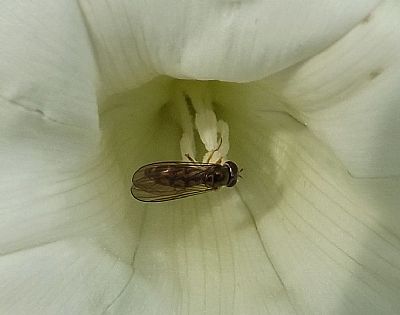
This example was seen in a bindweed flower in August.
MELISCAEVA CINCTELLA
This beautiful hoverfly is has an elongated body with very distinctive stripes. Its face is yellow with large brownish red eyes.
It is found across Europe and even Alaska, down the west of the USA to California and Colorado.
It frequents a range of leafy habitats and flowers such as this one. The flight period is April to September. The larva feeds on aphids on bushes, shrub and trees.
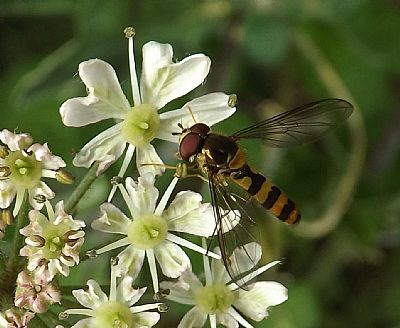
SCAEVA PYRASTRI
This one is typical of most hoverflies in form, but differs in its colour scheme. The abdomen is black with narrow white stripes.
It is common across most of Europe and parts of Asia and north Africa. Wiki tells us that it is a migrant to the UK; found in fairly large numbers in some years and not in others. Does its presence in Scotland tell us something of climate change?
The male's eyes do touch in the centre of the frons, while in the females they are separated. The larvae are light green or sometimes pink, with a white dorsal longitudinal stripe.
They fly from April to September, with the peak in July and August. [Wiki]. Our example was seen in August.
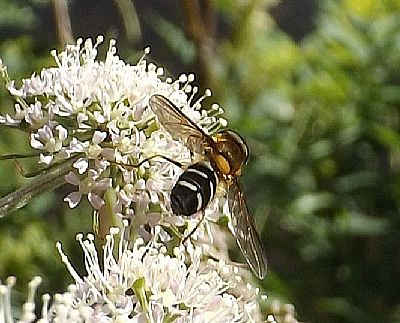
NATURE SPOT : https://www.naturespot.org.uk/species/syrphus-ribesii and https://www.naturespot.org.uk/gallery/hoverflies and https://www.naturespot.org.uk/species/eristalis-nemorum-interruptus
WIKIPEDIA : https://en.wikipedia.org/wiki/Meliscaeva_cinctella and https://en.wikipedia.org/wiki/Scaeva_pyrastri and https://en.wikipedia.org/wiki/Melanostoma_mellinum
WILDLIFE TRUSTS : https://www.wildlifetrusts.org/wildlife-explorer/invertebrates/flies/common-banded-hoverfly

